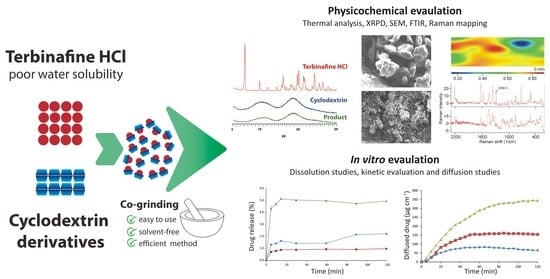Development of Solvent-Free Co-Ground Method to Produce Terbinafine Hydrochloride Cyclodextrin Binary Systems; Structural and In Vitro Characterizations
Abstract
:1. Introduction
2. Materials and Methods
2.1. Materials
2.2. Methods
2.2.1. Preparation of Co-Ground Mixtures
2.2.2. Phase Solubility Studies
2.2.3. Thermal Analysis
2.2.4. X-ray Powder Diffractometry (XRPD)
2.2.5. Fourier-Transform Infrared Spectroscopy (FT-IR)
2.2.6. Raman Spectroscopy
2.2.7. Scanning Electron Microscopy
2.2.8. In Vitro Dissolution Rate Studies
2.2.9. In Vitro Diffusion Studies
3. Results and Discussion
3.1. Phase Solubility Studies
3.2. Thermal Analysis
3.3. X-ray Powder Diffractometry
3.4. Hot-Stage X-ray Powder Diffractometry (HOT-XRPD)
3.5. Vibrational Spectroscopy
3.6. Scanning Electron Microscopy
3.7. Dissolution Studies
3.8. In Vitro Diffusion Studies
4. Conclusions
Supplementary Materials
Author Contributions
Funding
Institutional Review Board Statement
Informed Consent Statement
Data Availability Statement
Acknowledgments
Conflicts of Interest
References
- Savjani, K.T.; Gajjar, A.K.; Savjani, J.K. Drug solubility: Importance and enhancement techniques. ISRN Pharm. 2012, 2012, 195727. [Google Scholar] [CrossRef] [PubMed] [Green Version]
- Amidon, G.L.; Lennernäs, H.; Shah, V.P.; Crison, J.R. A theoretical basis for a biopharmaceutic drug classification: The correlation of in vitro drug product dissolution and in vivo bioavailability. Pharm. Res. 1995, 12, 413–420. [Google Scholar] [CrossRef] [PubMed] [Green Version]
- Kanakapura, B.; Penmatsa, V.K. Analytical methods for determination of terbinafine hydrochloride in pharmaceuticals and biological materials. J. Pharm. Anal. 2016, 6, 137–149. [Google Scholar] [CrossRef] [PubMed] [Green Version]
- Uzqueda, M.; Martin, C.; Zornoza, A.; Sanchez, M.; Vélaz, I. Physicochemical characterization of terbinafine-cyclodextrin complexes in solution and in the solid state. J. Incl. Phenom. Macrocycl. Chem. 2010, 66, 393–402. [Google Scholar] [CrossRef]
- Leyden, J. Pharmacokinetics and pharmacology of terbinafine and itraconazole. J. Am. Acad. Dermatol. 1998, 38, S42–S47. [Google Scholar] [CrossRef]
- Shear, N.H.; Villars, V.V.; Marsolais, C. Terbinafine: An oral and topical antifungal agent. Clin. Dermatol. 1991, 9, 487–495. [Google Scholar] [CrossRef]
- Balfour, J.A.; Faulds, D. Terbinafine: A review of its pharmacodynamic and pharmacokinetic properties, and therapeutic potential in superficial mycoses. Drugs 1992, 43, 259–284. [Google Scholar] [CrossRef]
- Van der Schroeff, J.G.; Cirkel, P.K.S.; Crijns, M.B.; Dijk, T.J.A.V.; Govaert, F.J.; Groeneweg, D.A.; Tazelaar, D.J.; Wit, R.F.E.D.; Wuite, J. A randomized treatment duration-finding study of terbinafine in onychomycosis. Br. J. Dermatol. 1992, 126, 36–39. [Google Scholar] [CrossRef]
- Stricker, B.H.C.; Van Riemsdijk, M.M.; Sturkenboom, M.C.J.M.; Ottervanger, J.P. Taste loss to terbinafine: A case-control study of potential risk factors. Br. J. Clin. Pharmacol. 2003, 42, 313–318. [Google Scholar] [CrossRef] [Green Version]
- Gupta, A.; Lynde, C.W.; Lauzon, G.J.; Mehlmauer, M.A.; Braddock, S.W.; Miller, C.A.; Del Rosso, J.Q.; Shear, N.H. Cutaneous adverse effects associated with terbinafine therapy: 10 case reports and a review of the literature. Br. J. Dermatol. 1998, 138, 529–532. [Google Scholar] [CrossRef]
- Ajit, C.; Zaeri, N.; Munoz, S.J.; Suvannasankha, A. Terbinafine-associated hepatotoxicity. Am. J. Med. Sci. 2003, 325, 292–295. [Google Scholar] [CrossRef] [PubMed]
- Szejtli, J. Utilization of cyclodextrins in industrial products and processes. J. Mater. Chem. 1997, 7, 575–587. [Google Scholar] [CrossRef]
- Rasheed, A.; Kumar, A.; Sravanthi, V.V.N.S.S. Cyclodextrins as drug carrier molecule: A review. Sci. Pharm. 2008, 76, 567–598. [Google Scholar] [CrossRef]
- Loftsson, T.; Duchêne, D. Cyclodextrins and their pharmaceutical applications. Int. J. Pharm. 2007, 329, 1–11. [Google Scholar] [CrossRef]
- Davis, M.E.; Brewster, M.E. Cyclodextrin-based pharmaceutics: Past, present and future. Nat. Rev. Drug Discov. 2004, 3, 1023–1035. [Google Scholar] [CrossRef]
- Jacob, S.; Nair, A.B. Cyclodextrin complexes: Perspective from drug delivery and formulation. Drug Dev. Res. 2018, 79, 201–217. [Google Scholar] [CrossRef]
- Hamai, S.; Kikuchi, K. Room-temperature phosphorescence of 6-bromo-2-naphthol in poly(vinyl alcohol) films containing cyclodextrins. J. Photochem. Photobiol. A Chem. 2003, 161, 61–68. [Google Scholar] [CrossRef]
- Jug, M.; Mura, P. Grinding as solvent-free green chemistry approach for cyclodextrin inclusion complex preparation in the solid state. Pharmaceutics 2018, 10, 189. [Google Scholar] [CrossRef] [Green Version]
- Cirri, M.; Bragagni, M.; Mennini, N.; Mura, P. Development of a new delivery system consisting in “drug—In cyclodextrin—In nanostructured lipid carriers” for ketoprofen topical delivery. Eur. J. Pharm. Biopharm. 2012, 80, 46–53. [Google Scholar] [CrossRef]
- Maestrelli, F.; Cirri, M.; Mennini, N.; Zerrouk, N.; Mura, P. Improvement of oxaprozin solubility and permeability by the combined use of cyclodextrin, chitosan, and bile components. Eur. J. Pharm. Biopharm. 2011, 78, 385–393. [Google Scholar] [CrossRef]
- Imono, M.; Uchiyama, H.; Yoshida, S.; Miyazaki, S.; Tamura, N.; Tsutsumimoto, H.; Kadota, K.; Tozuka, Y. The elucidation of key factors for oral absorption enhancement of nanocrystal formulations: In vitro–in vivo correlation of nanocrystals. Eur. J. Pharm. Biopharm. 2020, 146, 84–92. [Google Scholar] [CrossRef] [PubMed]
- Solares-Briones, M.; Coyote-Dotor, G.; Páez-Franco, J.C.; Zermeño-Ortega, M.R.; de la O Contreras, C.M.; Canseco-González, D.; Avila-Sorrosa, A.; Morales-Morales, D.; Germán-Acacio, J.M. Mechanochemistry: A green approach in the preparation of pharmaceutical cocrystals. Pharmaceutics 2021, 13, 790. [Google Scholar] [CrossRef]
- Cirri, M.; Maestrelli, F.; Mennini, N.; Mura, P. Influence of the preparation method on the physical–chemical properties of ketoprofen–cyclodextrin–phosphatidylcholine ternary systems. J. Pharm. Biomed. Anal. 2009, 50, 690–694. [Google Scholar] [CrossRef] [PubMed]
- Lin, H.-L.; Lin, S.-Y.; Lin, C.-C.; Hsu, C.-H.; Wu, T.-K.; Huang, Y.-T. Mechanical grinding effect on thermodynamics and inclusion efficiency of loratadine–cyclodextrin inclusion complex formation. Carbohydr. Polym. 2012, 87, 512–517. [Google Scholar] [CrossRef] [PubMed]
- Chouhan, P.; Saini, T.R. Hydroxypropyl-β-cyclodextrin: A novel transungual permeation enhancer for development of topical drug delivery system for onychomycosis. J. Drug Deliv. 2014, 2014, 950358. [Google Scholar] [CrossRef] [Green Version]
- Higuchi, T.; Connors, K. Phase-solubility techniques. Adv. Anal. Chem. Instr. 1965, 4, 117–122. [Google Scholar]
- Khan, K.A. The concept of dissolution efficiency. J. Pharm. Pharmacol. 2011, 27, 48–49. [Google Scholar] [CrossRef]
- Tanigawara, Y.; Yamaoka, K.; Nakagawa, T.; Uno, T. New method for the evaluation of in vitro dissolution time and disintegration time. Chem. Pharm. Bull. 1982, 30, 1088–1090. [Google Scholar] [CrossRef] [Green Version]
- Harris, D.C.; Bertolucci, M.D. Symmetry and Spectroscopy, an Introduction to Vibrational End Electronic Spectroscopy; Dover Publ. Inc.: New York, NY, USA, 1978. [Google Scholar]
- Kuminek, G.; Rauber, G.S.; Riekes, M.K.; de Campos, C.E.M.; Monti, G.A.; Bortoluzzi, A.J.; Cuffini, S.L.; Cardoso, S.G. Single crystal structure, solid state characterization and dissolution rate of terbinafine hydrochloride. J. Pharm. Biomed. Anal. 2013, 78–79, 105–111. [Google Scholar] [CrossRef]
- Tayel, S.A.; El-Nabarawi, M.A.; Tadros, M.I.; Abd-Elsalam, W.H. Positively charged polymeric nanoparticle reservoirs of terbinafine hydrochloride: Preclinical implications for controlled drug delivery in the aqueous humor of rabbits. AAPS PharmSciTech 2013, 14, 782–793. [Google Scholar] [CrossRef] [Green Version]
- Colthup, N.; Daly, L.; Wiberley, S. Introduction to Infrared and Raman Spectroscopy; Academic Press: New York, NY, USA, 1990; pp. 279–280. [Google Scholar]
- Hanopolskyi, A.I.; Smaliak, V.A.; Novichkov, A.I.; Semenov, S.N. Autocatalysis: Kinetics, mechanisms and design. ChemSystemsChem 2021, 3, e2000026. [Google Scholar] [CrossRef]
- Van Driessche, A.E.S.; Van Gerven, N.; Bomans, P.H.H.; Joosten, R.R.M.; Friedrich, H.; Gil-Carton, D.; Sommerdijk, N.A.J.M.; Sleutel, M. Molecular nucleation mechanisms and control strategies for crystal polymorph selection. Nature 2018, 556, 89–94. [Google Scholar] [CrossRef] [PubMed] [Green Version]
- Pagliari, L.; Dapiaggi, M.; Pavese, A.; Francescon, F. A kinetic study of the quartz–cristobalite phase transition. J. Eur. Ceram. Soc. 2013, 33, 3403–3410. [Google Scholar] [CrossRef]
- Turrell, G.; Delhaye, M.; Dhamelincourt, P. Characteristics of Raman microscopy. In Raman Microscopy, Developments and Applications; Academic Press: New York, NY, USA, 1966; pp. 27–49. [Google Scholar]
- Barbillat, J. Raman imaging. In Raman Microscopy, Developments and Applications; Academic Press: New York, NY, USA, 1966; pp. 175–200. [Google Scholar]
- Dahan, A.; Miller, J.M.; Hoffman, A.; Amidon, G.E.; Amidon, G.L. The solubility–permeability interplay in using cyclodextrins as pharmaceutical solubilizers: Mechanistic modeling and application to progesterone. J. Pharm. Sci. 2010, 99, 2739–2749. [Google Scholar] [CrossRef] [Green Version]
- Beig, A.; Agbaria, R.; Dahan, A. Oral delivery of lipophilic drugs: The tradeoff between solubility increase and permeability decrease when using cyclodextrin-based formulations. PLoS ONE 2013, 8, e68237. [Google Scholar] [CrossRef]
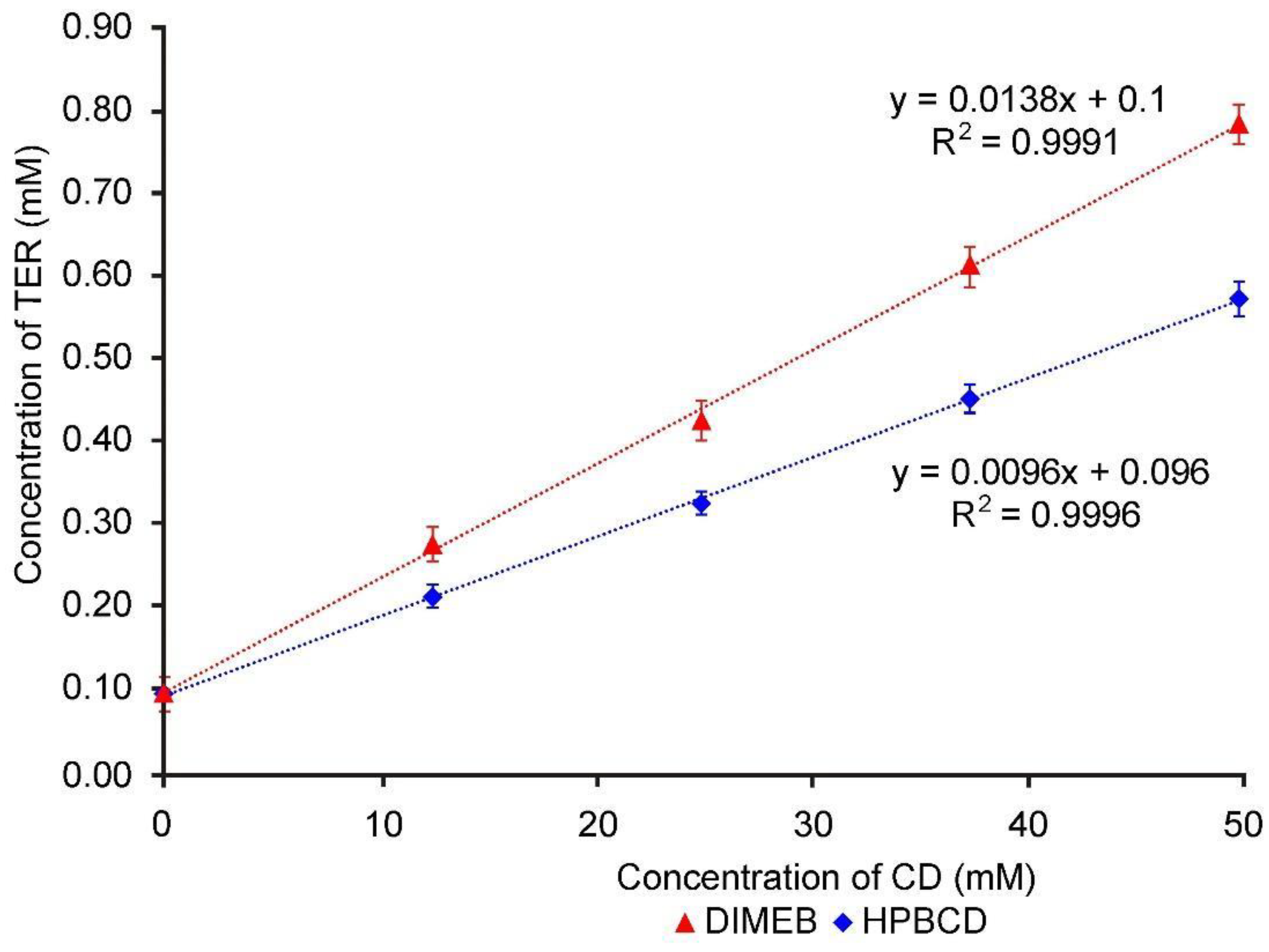
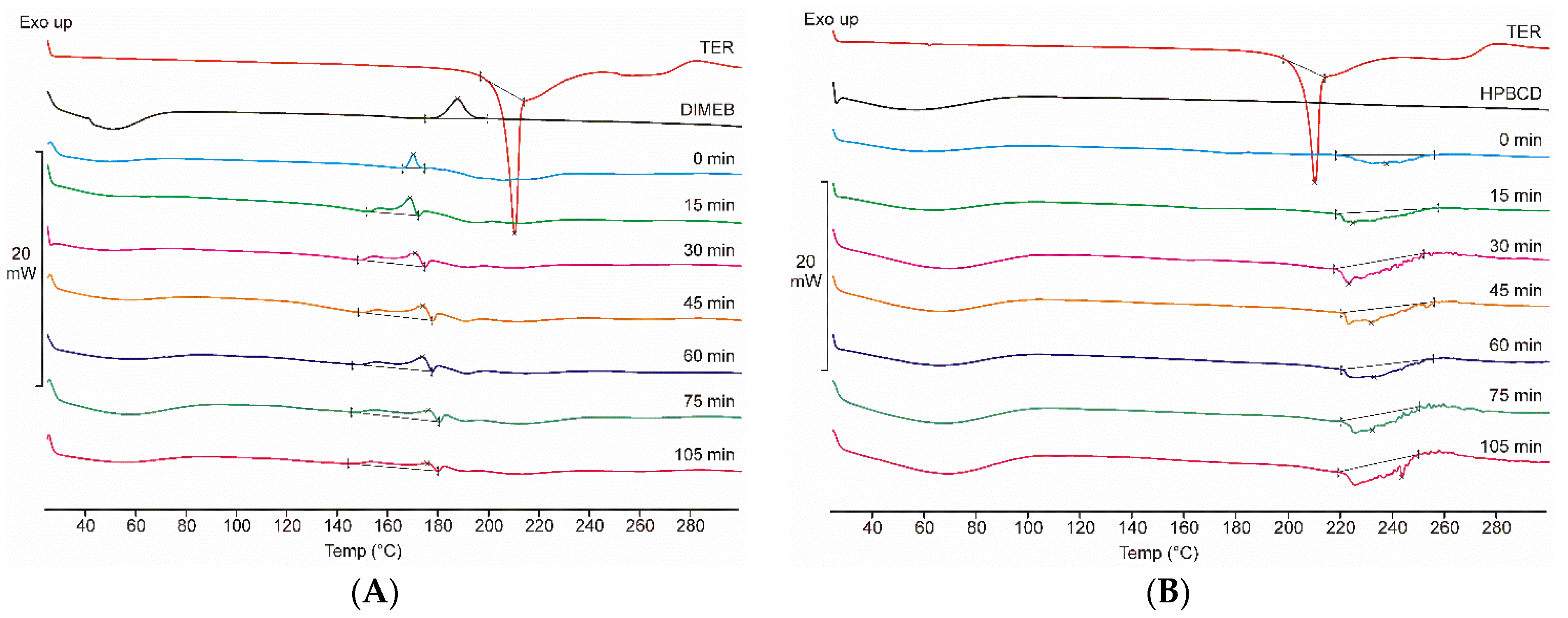


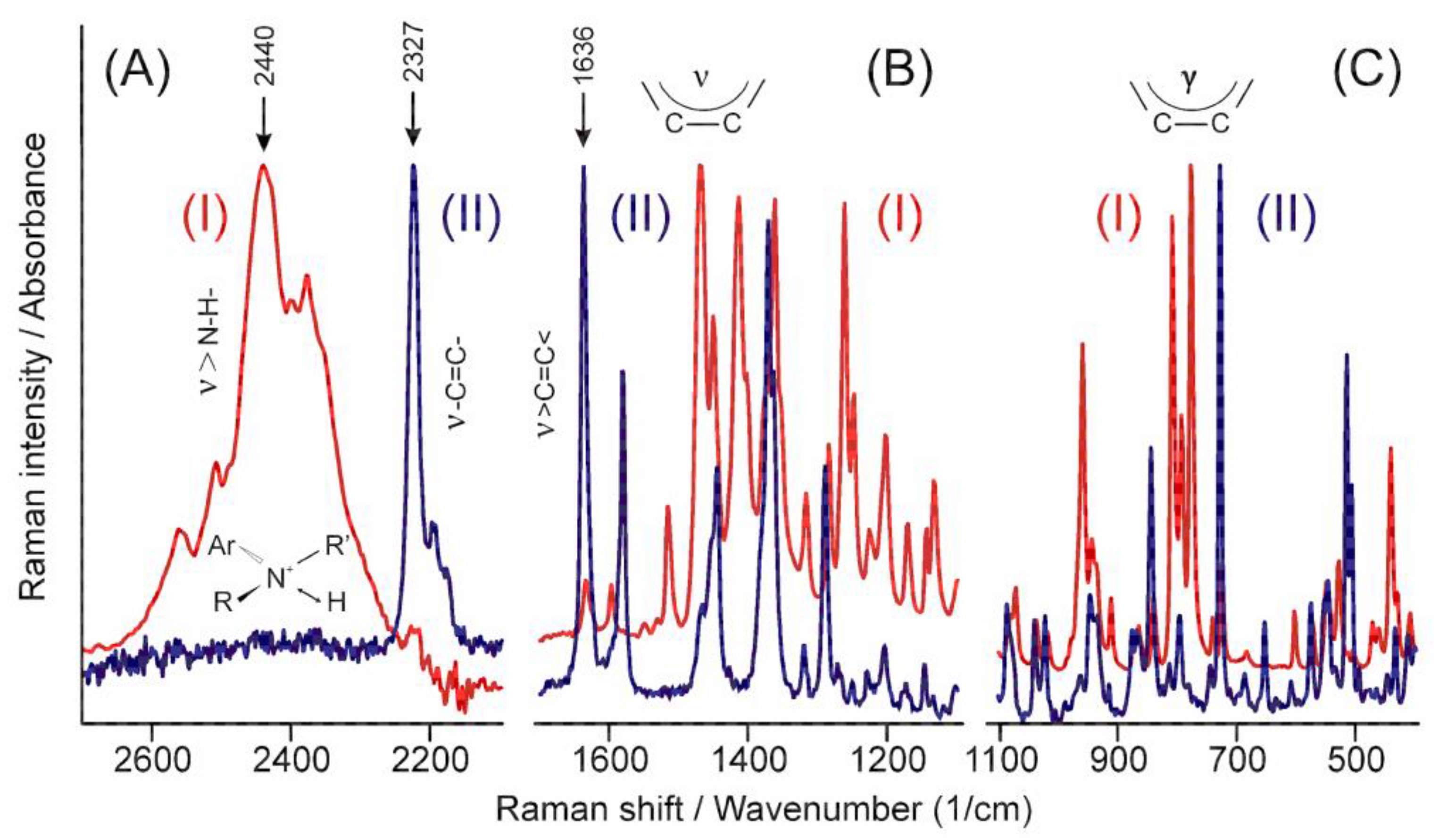

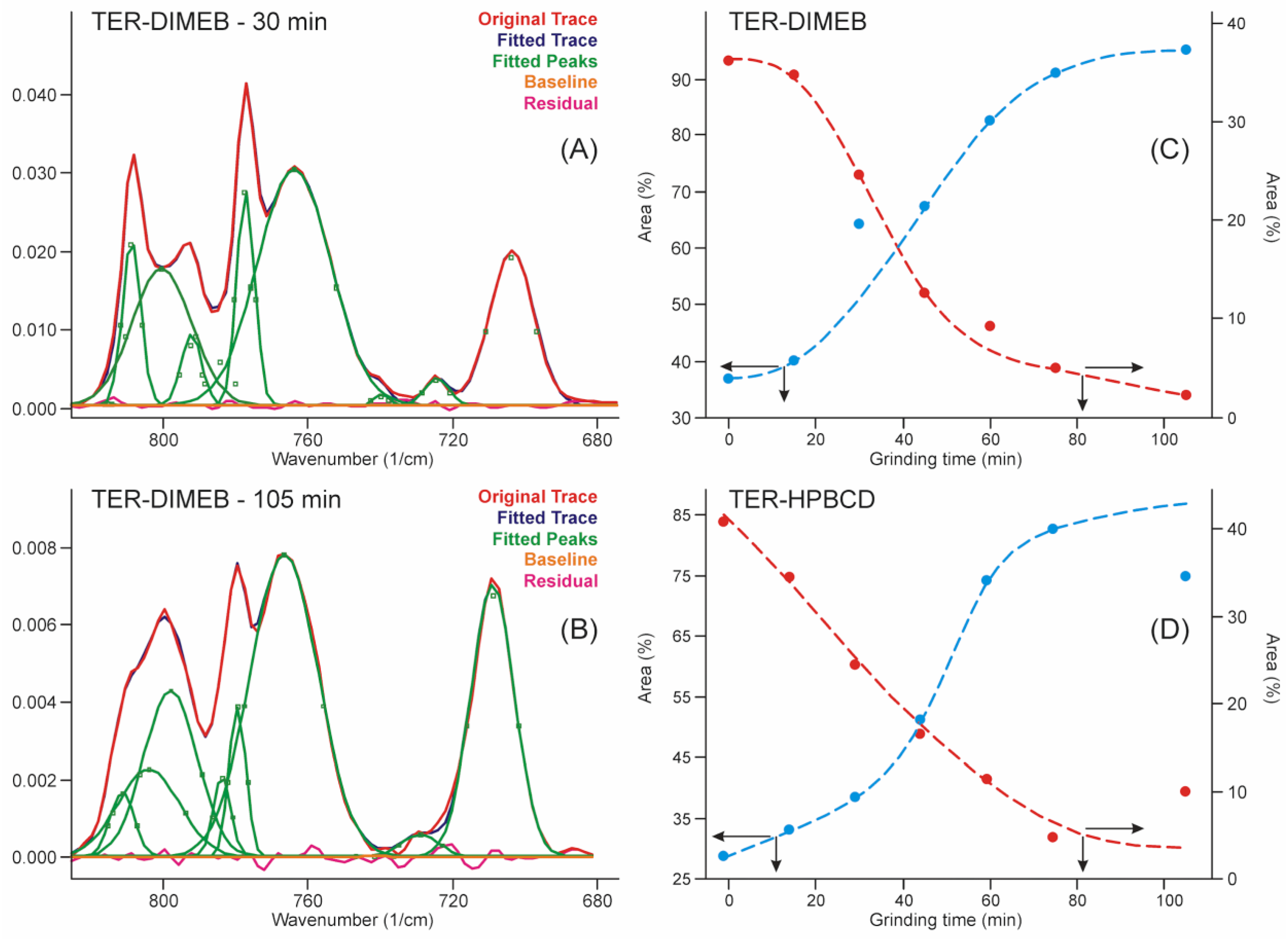


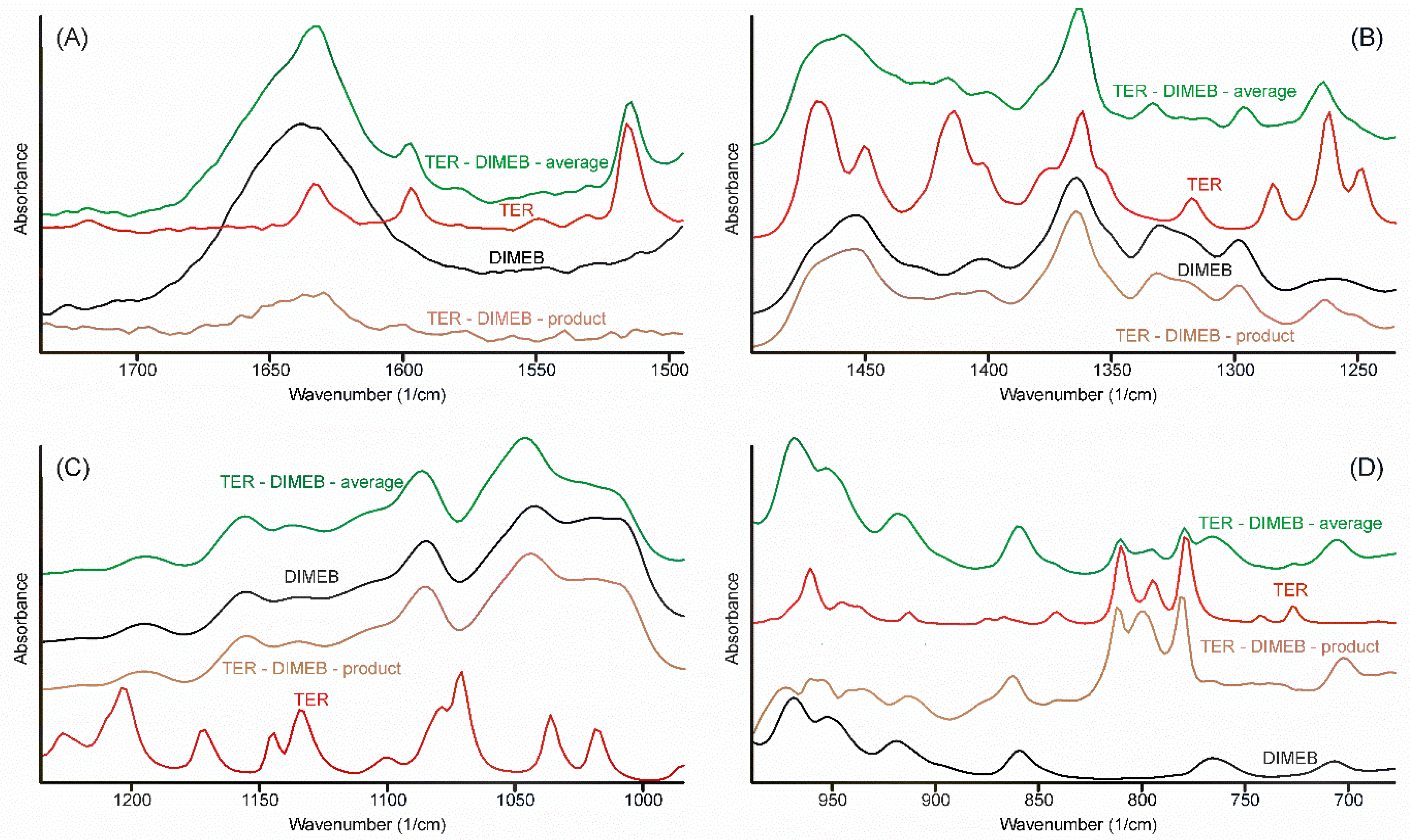

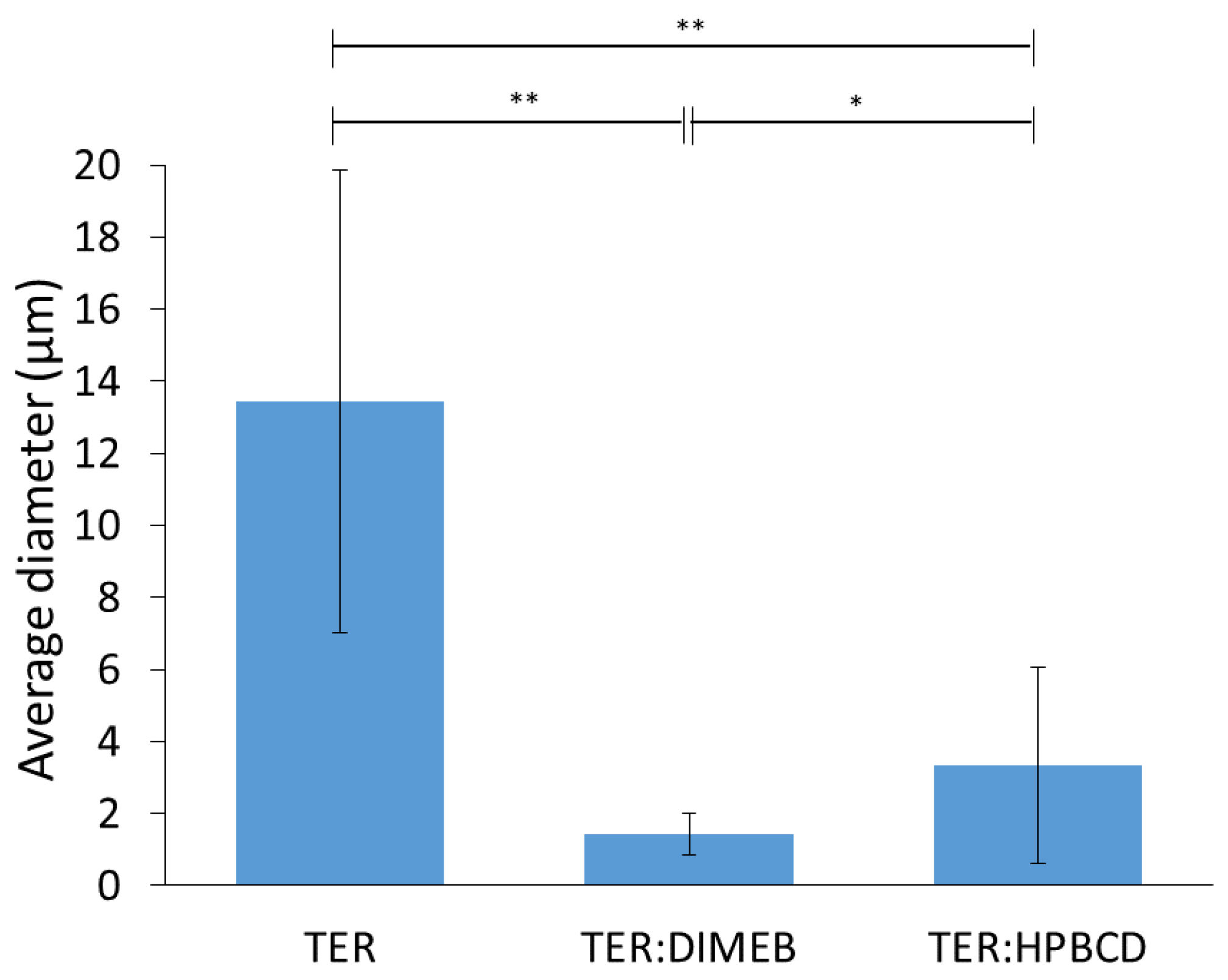
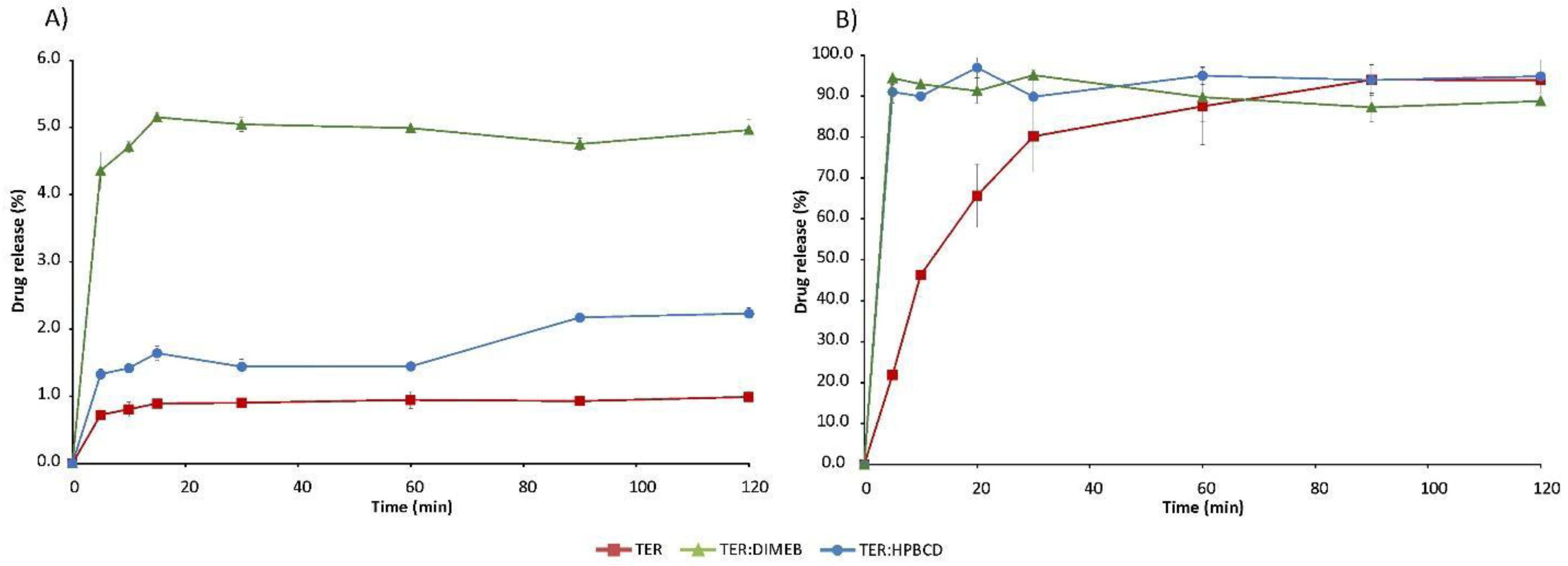
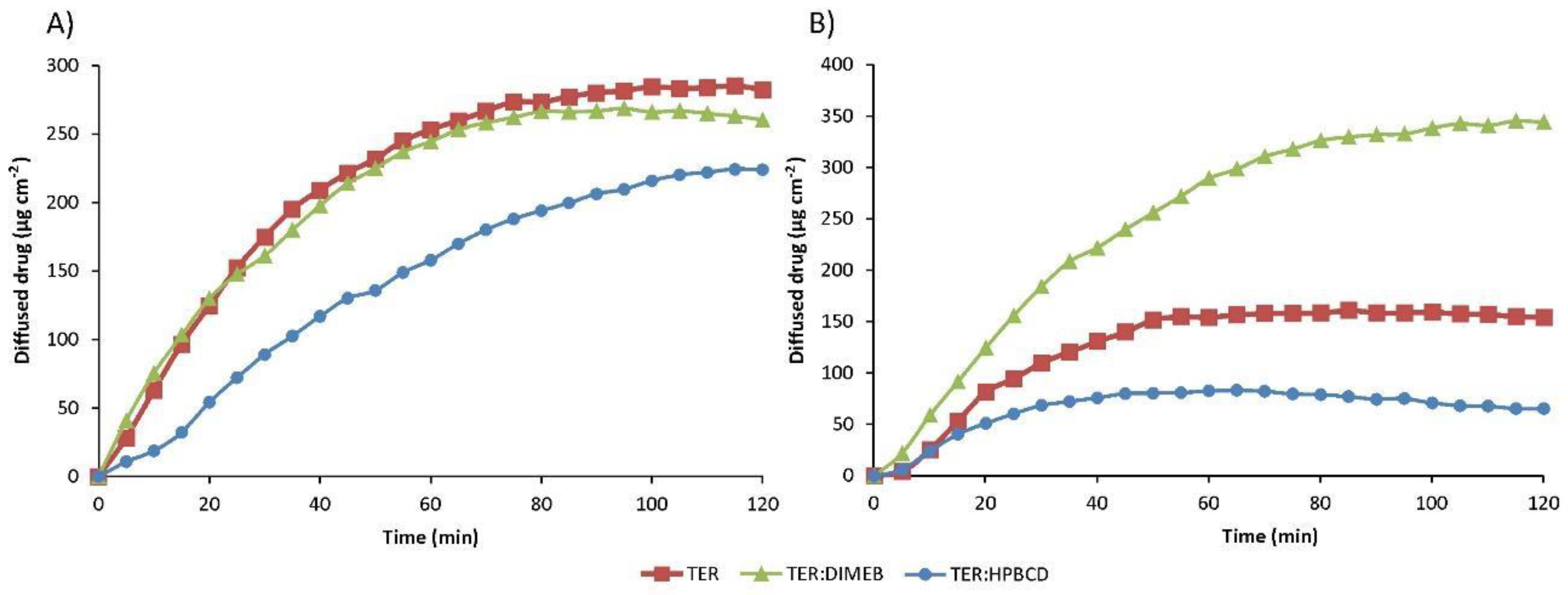
| Simulated Intestinal Medium | Simulated Gastric Medium | |||||||
|---|---|---|---|---|---|---|---|---|
| DE30min | DE60min | DE120min | MDT | DE30min | DE60min | DE120min | MDT | |
| TER | 0.78 ± 0.03 | 0.85 ± 0.05 | 0.90 ± 0.04 | 18.88 ± 7.49 | 53.30 ± 5.63 | 68.57 ± 6.91 | 80.45 ± 5.19 | 18.35 ± 2.69 |
| TER:DIMEB | 4.49 ± 0.10 | 4.75 ± 0.09 | 4.81 ± 0.09 | 11.02 ± 2.00 | 84.94 ± 0.82 | 88.68 ± 1.50 | 91.54 ± 1.02 | 12.54 ± 6.08 |
| TER:HPBCD | 1.37 ± 0.06 | 1.40 ± 0.04 | 1.70 ± 0.02 | 28.86 ± 1.63 | 85.71 ± 1.53 | 88.80 ± 0.84 | 88.54 ± 1.32 | 7.69 ± 5.68 |
| Simulated Intestinal Medium | Simulated Gastric Medium | |||
|---|---|---|---|---|
| Papp (cm s−1) | R | Papp (cm s−1) | R | |
| TER | 1.41 × 10−4 | 7.72 × 10−6 | ||
| TER:DIMEB | 1.3 × 10−4 | 0.921 | 1.72 × 10−4 | 2.232 |
| TER:HPBCD | 1.12 × 10−4 | 0.793 | 3.28 × 10−5 | 0.425 |
Publisher’s Note: MDPI stays neutral with regard to jurisdictional claims in published maps and institutional affiliations. |
© 2022 by the authors. Licensee MDPI, Basel, Switzerland. This article is an open access article distributed under the terms and conditions of the Creative Commons Attribution (CC BY) license (https://creativecommons.org/licenses/by/4.0/).
Share and Cite
Kondoros, B.A.; Jójárt-Laczkovich, O.; Berkesi, O.; Szabó-Révész, P.; Csóka, I.; Ambrus, R.; Aigner, Z. Development of Solvent-Free Co-Ground Method to Produce Terbinafine Hydrochloride Cyclodextrin Binary Systems; Structural and In Vitro Characterizations. Pharmaceutics 2022, 14, 744. https://doi.org/10.3390/pharmaceutics14040744
Kondoros BA, Jójárt-Laczkovich O, Berkesi O, Szabó-Révész P, Csóka I, Ambrus R, Aigner Z. Development of Solvent-Free Co-Ground Method to Produce Terbinafine Hydrochloride Cyclodextrin Binary Systems; Structural and In Vitro Characterizations. Pharmaceutics. 2022; 14(4):744. https://doi.org/10.3390/pharmaceutics14040744
Chicago/Turabian StyleKondoros, Balázs Attila, Orsolya Jójárt-Laczkovich, Ottó Berkesi, Piroska Szabó-Révész, Ildikó Csóka, Rita Ambrus, and Zoltán Aigner. 2022. "Development of Solvent-Free Co-Ground Method to Produce Terbinafine Hydrochloride Cyclodextrin Binary Systems; Structural and In Vitro Characterizations" Pharmaceutics 14, no. 4: 744. https://doi.org/10.3390/pharmaceutics14040744
APA StyleKondoros, B. A., Jójárt-Laczkovich, O., Berkesi, O., Szabó-Révész, P., Csóka, I., Ambrus, R., & Aigner, Z. (2022). Development of Solvent-Free Co-Ground Method to Produce Terbinafine Hydrochloride Cyclodextrin Binary Systems; Structural and In Vitro Characterizations. Pharmaceutics, 14(4), 744. https://doi.org/10.3390/pharmaceutics14040744







